James Christensen
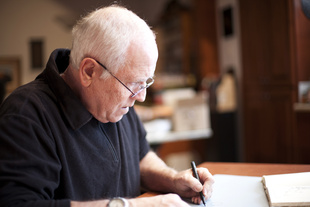
How did you get started as an artist?
I actually didn’t start as an artist. I think I came pre-wired that way. In my earliest memories I was drawing. And it was not as a passion, or a mission, it was just what I liked to do. I really liked to make stuff up and I liked to put things down on paper. I’d have to go to church as a little kid and sometimes my dad would be on the stand—my mother was ill a lot—and he’d say, “If you’ll be quiet, you can draw,” and he’d give me a little spiral notebook and his pen and I could draw in church. Those are my earliest memories of drawing: sitting on the end of the pew being rather nervous about being by myself while Dad was up there, but I could get lost in a drawing and then I was okay.

Do you still doodle at church?
I do draw in church. In fact, even after I became a bishop, it was sort of known that I wasn’t tuning out, I was just drawing. And I take notes: in my sketchbooks and my notebooks, I have thoughts that occur to me, ideas for paintings, doodles, lists. I’m pushing sixty bound volumes of sketchbooks. I hang onto those. I get nice ones now and put them on a shelf.
Do you still have your early ones?
The little spiral ones? No. Those are when I was four. The stuff I have now I started probably close to forty years ago and they are as close as I come to a journal. It’s just a very visual journal.
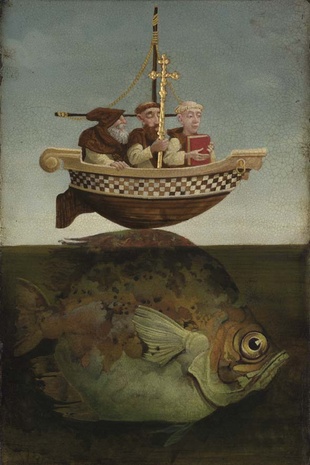
When did you come to a moment where you found the visual language that you stuck with?
Probably when I was thirty-five. That didn’t happen when I was a kid. First of all, when you’re a kid, you’re not concerned about style or anything, you’re just making stuff up and that’s very cool. When you get into school, you’re looking for a style, and I was doing this funky fantasy stuff in the background in my own sketchbooks and stuff, but not really painting it, because I didn’t think anybody would be interested. And it wasn’t until I was a grownup that some of my contemporaries said, “We want you to paint some of the things that you doodle in your books.” And so I was in my mid-thirties before I started putting what you would call the fantasy work out there.
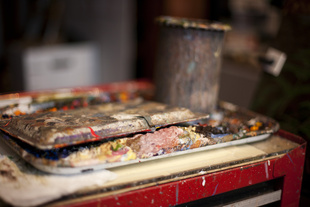
You don’t call it fantasy art?
I would just call it my images. Every artist needs to have a label. The world says it’s so much easier if we can put you in a box. So I accept that because my things aren’t realistic, they’re fantastical and whatever.
So we have this image of you alone on the sacrament pew drawing to cope. How does your art help you deal with challenges?
I use my art as therapy sometimes. I’ll draw the little man burdened by way too much stuff or the fellow that nobody’s paying any attention to. That becomes visual to me very quickly. My brain tends to make metaphorical, symbolic connections a lot. Even if it’s not visual images, I can, when I’m teaching in Church, get talking about the iron rod and you know, Nephi and Lehi just brushed the surface. There is so much meaning and so much potential and so many layers in those few verses.

Explain the obvious illusion that we see in many of your paintings.
I painted a painting called “The Invisible Door” when I first started teaching and it was a very early kind of fantasy metaphorical painting, my first hunchback painting—it was me examining death. I’m seeing this beautiful Portuguese seaside, rocks, beach—which is my idea of heaven—and perhaps an invisible door and I’m questioning: “Do I see paradise or am I going to open the door and there’s poop up to my chin and it was an illusion?” I don’t know what’s beyond the door. And then, ten years later—and the timing was purely accidental—I painted “The Last E-ticket Ride.”
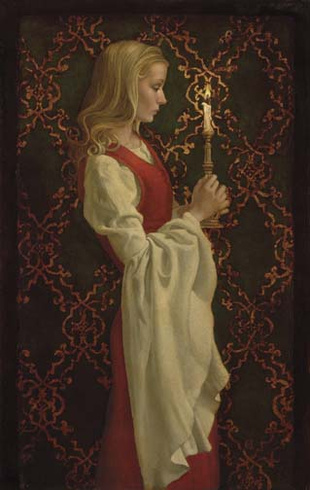
Every decade or so, I get thinking about that sort of thing. And I realized after the fact that I’d painted these paintings ten years apart. So I said, every decade I will look at death and figure out what it looks like and how I’m thinking about it. Ten years later, I painted “Opus 96.” For me it’s the least successful because it was kind of contrived. I was saying, “Okay, my decade’s up, now what am I thinking about death? Where’s my life? How are things different?” The painting works right, but to me it was much too self-conscious. The bright light is at the end of the passageway on the side and it’s way down the hall, but the closer you get to that part you see the trees are nailed and propped up and it’s a movie set; that was my response to the fact that as you get older, you start to see things as they really are. The experience of your life simply teaches you what’s real and what’s not.
I thought I was done. Then, kind of accidentally, about eight years later I did a fourth death painting called “Death and the Mirror.” That was when I was diagnosed with cancer. We had a very scary year or so. That’s the angel in black holding the mirror up to the lady in all of her finery and all it shows is the lady’s face. When you’re face to face with the real idea of death, which isn’t scary—she was actually quite an attractive woman—nothing counts anymore but what you really are, what your own face is, what your own spirit is like.
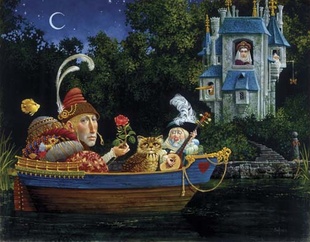
How did your faith grow because of your battle with cancer?
Of course my illness changed my perspective a little bit and there’s a happy ending to it—we did treatments and everything’s fine. I believe that it’s one of the things I was supposed to experience because it changed my perspective and made me think more about my own mortality and what I was doing that counted—not just busy work, but whether I was using the time that I had. Was I using it well? Wisely? So, yes, it had an effect. Did it turn me morbid? No. Does it affect my work a lot on a day-to-day basis? I don’t think so.

What advice do you have for following one’s dreams?
I think that if part of why we’re here is to find happiness, then I think it’s pretty important to find that which will make us happy and gives us a sense of accomplishment. I’m a big proponent of following your dreams, of doing that which fulfills you, that which gives you satisfaction and which you love.
I spent too much of my own life in what I call my “anything-for-a-buck years,” and because of my upbringing in a post-WWII economy by parents who’d been through the Depression, work had a meaning and that meaning wasn’t fun. I did a lot of artwork that I didn’t enjoy doing but that usually made me money. I was into my thirties before I figured out that if I follow my bliss, that which I create or I get good at is what’s going to be the most valuable. So now I try with my children and with students that I’ve had at the university, to say, you’ve got to find what makes you happy. Don’t be in a hurry to do that. You’ve got to experiment. I don’t want you to narrow down too fast, but then do what’ll make you happy. And do what you need to do.
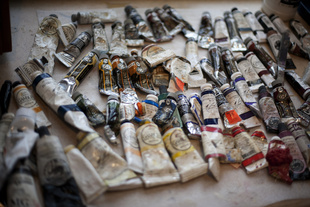
See, when a parent comes with a kid who is out of high school and they’re coming to BYU to be an artist, and they ask, should my son be an artist? My response to that is to look at the kid and say, kid, what else do you like to do? “Well, you know, I like rocket science and I like crocheting and I love life insurance business, you know, but I also like art.” I say, then pick one of the other three. Be a rocket science or an insurance salesman, don’t be an artist. If the kid says, “Eh, I don’t know. Art. I love to draw, I love to paint, I love to sculpt—that’s all I want to do,” then I say, be an art major. No, parent, you’re not necessarily going to see him make any money at it, that’s not why he’s doing it. But if he has to do it, then he has to do it. I believe in that.
Having said that, though, I also believe in balance. It’s very important to have a balanced life and a balanced education. I tend not to advise kids to go to art schools because I think a liberal arts education is tremendously important just to make you culturally literate.
I think that’s evident in my work because I’m putting in little references all over—a botany reference, a mythological reference. I’ve had people say, “I’m not smart enough to understand your paintings.” Well, you can enjoy them on a level, but the more you know, the more you’re going to see things going on.
But, back to the topic, to say, “I want to be an artist. I want to be an artist so bad I’m going to live in a cardboard box under the freeway and I’m going to paint and I’m never going to take on the responsibilities of a family or service or anything because I need to be an artist,” is baloney and it’s wrong.

You have to build your life so that if you’re going to have a family—and you probably should—then you have to accommodate making a living and taking care of your family. That’s a really important thing.
Now, if it gets to the point where you get paid a lot of money to do your passion, then you’ve hit the jackpot. That’s the best. And the best way to get there is to get really good at what you do—and if you’re the best, then you’re going to find a way to make a living at it.
Tell us about painting fantasy versus reality.
One of the advantages of being labeled “the fantasy guy” is that you’re not bound, you’re not the landscape guy, you’re not the naturalist fish guy, you are the “fantasy-poofy-dwarf guy” and you can do whatever the heck you want.
I like that there’s a broad spectrum there. I can do something that is quite realistic and believable, but without missing a beat I can move into something where perspective is tilted up, where things are very flat. I don’t have any trouble moving back and forth.
I don’t like being hobbled by the rules of atmospheric perspective or linear perspective or “Is that the proper depth of field?” or “Is that floor on exactly the right angle?”
I prefer the medieval manuscript painters, the early Gothic painters, who simply weren’t worried about that. When perspective serves me, I use it; when it doesn’t, I don’t. And I don’t find a problem with that because what is important is the painting and the idea and the presentation.
I’m not a trompe-l’œil painter. I’m not painting the illusion to get you to buy the idea. I’m painting what works for the painting.
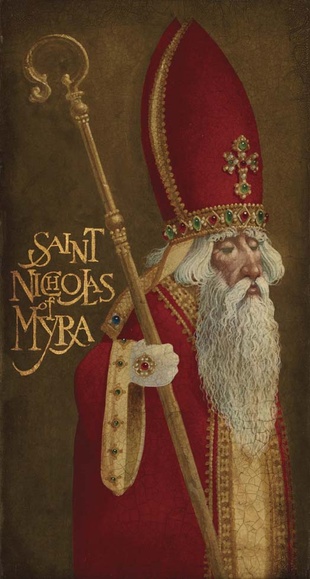
Wordplay in your painting has been very important to you. What do you read?
I read voraciously. However, I don’t look at printed words a lot. I listen to books while I’m painting. So, if I told you I’d read fifty or sixty books last year, I’ve listened to fifty or sixty books. I probably read four.
I have very broad tastes in what I enjoy. I love history, I like historical fiction, I like a good whodunnit or a pageturner, occasionally some fantasy. I like vivid imagery in fantasy reading. I’m just finishing up Fablehaven, which was Brandon Mull’s work, and my granddaughters got me reading that. I told Brandon, “The thing I like is that you make me see pictures in my head of what you’re doing—you describe it well.” That’s super for me.
Tell us about raising your kids with your love of whimsy and imagination.
As they were growing up, I didn’t think of it as being different or odd or magical. Art was my job and so I was fairly matter-of-fact. In retrospect now, yes, we had adventures and did goofy stuff and played Dungeons & Dragons and made a few home movies and did those deliberately creative things, but a lot of the time I was in my studio and the sign on the door said, “Unless you are on fire, do not open the door because I’m working.” I had my studio at home. I liked being around.
Two of my kids are practicing painters and the third one is an art history/ceramics person and very involved in the arts. I did not tutor them to become artists. I believe that art is a very hard thing to do as a business, or a career. You don’t do it for those reasons; you do it because you have a fire in the belly. You’re an artist because you can’t not be. And so I provided stuff for my kids and I answered questions if they needed questions answered, but I was as surprised as anybody when three of them said, “I think I’m going to be an art major,” and that was totally their decision. I think it has to be that way.
How does your being an artist facilitate your understanding and testimony of the gospel?
I think that my art helps because the investigations I make into the things I want to paint and talk about and discuss, inform my religious self to some extent. Also, the decisions I’ve made through my religious life have affected what I choose to paint. I choose to paint generally positive and uplifting things. Even if I’m critical, I try to be critical in a whimsical way where you laugh because this guy has no clue about anything and yet we are sort of chuckling at him as we go. So I try not to paint the dark side very much.
I was talking to Elder Packer once and he said, “It would be wonderful if art could be about what might be, or ought to be, rather than what is.” We were talking about how a lot of contemporary art illustrates the dark side—the depraved or unhappy or violent or angst-driven part of life. I can watch the news if I want angst. What I want to contribute is something short of Pollyanna-ism that offers a positive outlook, that offers beauty, that offers uplifting thoughts rather than a “life is poopy and then you die” sort of thing.
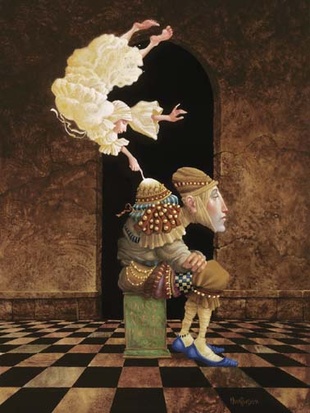
So how do you compartmentalize your church service and your artistic service?
I think that it is dangerous to compartmentalize, at least for me. I started out that way. I started out with my art here, my church here, my family here, and I kept everything in tidy little boxes and not very connected together and that was the way I operated, unconsciously. I was a fairly young artist when I had a few spiritual experiences and opportunities that made me aware right off that I should not compartmentalize.
Now, does that mean I just paint Bible stories? No, not at all. That’s not where my art has taken me. But when people say to me, “You’re a Mormon and you don’t do Jesus paintings and Mormon stuff and you haven’t done Joseph Smith very much—what’s your deal?” I say there’s a spiritual aspect, too. Most of what I do isn’t necessarily a narrative of either a spiritual event or a scriptural setting, but my values—what’s important and what is of worth—absolutely spill over from my family and my religious life into my artwork.
How has having a testimony of the gospel helped you be more successful?
When I was a young artist working at the New Era, I was invited into Elder Packer’s office. He was preparing a talk for BYU called “Arts and the Spirit of the Lord” and he wanted to hear from artists and see what we dealt with and struggled with, and so he wanted to interview me. I said my biggest problem with being a young artist who is trying to get good and make a living at it is that I’m limited in time because I have committed myself to church service. I do my home teaching and I have my family, which is a huge part of the gospel plan, and I do my church work and I attend all my meetings and it just cuts down the time in the studio and I feel like I’m never going to catch Joe Gentile down the street who doesn’t go to church, doesn’t have a family, doesn’t pay attention, and he paints all the time, and he’s going to paint one hundred paintings in a year and I’m going to be lucky if I get forty or fifty because I just don’t have time to do more. That’s a frustration. Having said that, I still am going to seek the kingdom first—I made that decision a while back.
He gave me that “silly mortal look” that they can do and he said, “Did it never occur to you while you pray and go to church and do your home teaching and study your scriptures, why you are doing that? What you are doing that for? You’re doing it so you can have the Spirit. And that Spirit can help you in everything you do.”
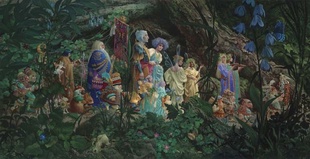
It’s taken me a long to time to really internalize that, but that was the beginning of it, and he said, “You can accomplish more with the Spirit in twenty paintings than Joe Gentile down the street can without the Spirit in one hundred paintings. So, you’re doing things for the right reason. You’re just not paying attention to why you’re doing them.”
That became important in my life. I feel like I’ve been blessed that way. I mean, opportunities have come when I needed an opportunity to come, and there are a few things I’ve missed out on, but at the end of the day, I feel like there were reasons why I missed them.
I got a call from Pixar saying, “We’re doing this thing and we like your artwork and we want you to come brainstorm.” I was working on a Church project so I said I just can’t get away. “Well, we’ll call you again.” A couple of years later they called me and said, “We really want you to come out and brainstorm with us. We’re doing a new movie—we can’t talk about it until you sign the non-disclosure agreements and all that—but we can tell you it’s a fish movie, and you’re the fish guy. We want you to fly out to San Francisco.” At the time I was painting a Church mural and I just couldn’t do it. Turned out it was Finding Nemo. I really liked that movie and would have loved to have been part of that experience, but my wife is convinced that there is a Church project every time I get invited to Hollywood so I can’t get out, because I could be seduced by that pretty easily. It’s interesting and exciting to do movies, but I could also get lost in it. I don’t worry about those things that went by.
Kids ask, “What was your game plan?” When I say I didn’t have a plan, it wasn’t that I sat around watching TV until somebody famous called me. Malcolm Gladwell wrote a book called Outliers which is a really interesting study of successful people. They have several things in common, and one of them is that you don’t get good at something until you’ve done it for 10,000 hours. I tried to get good, to get prepared, to do the best at my craft that I could, and to stay busy—I worked all the time. And so, when an opportunity came—“Would you like to work on this?” “Would you like to paint a temple mural?” “Would you like to do prints with Greenwich?”—I was prepared and ready so when the opportunity was there I could take advantage of it.

What it is like working on a temple mural?
Oh, that was a great experience. There were six of us who were called to do murals for the Nauvoo temple. That was one of those tender mercies, opportunities that come. When I was a kid I went to the open house of the L.A. Temple and saw these magnificent huge paintings. The rooms are huge. In my twelve-year-old head, I thought, “No artist could do anything greater than paint a mural in a temple,” and then they quit doing it. L.A. was the last temple that had them, for a lot of years, and that boat had sailed.
Time soldiered on, and then I got a phone call from one of my teachers, Frank Magleby, who said, “How would you like to paint a temple mural?” I said, “Well, sure.” I didn’t take it really seriously. I didn’t know quite what he had in mind. He said, “They’re rebuilding the Nauvoo temple, and they want to do three rooms of teaching murals. They’ve asked me to put a team together to do it, and I would love to have you on that team.”
We spent about a year working, on and off. We painted them in the movie studio at BYU. They built the walls to scale. We each did half a room. I thought, “I really want to paint the garden. I am intrigued with that whole concept. But I might have to fight for it.” As it turned out, two of the artists said, “We want to paint the world room,” and another artist and I wanted to paint the garden, and the other two said, “Great, because we wanted to paint creation.” And the styles of the pairings were close enough that for the uninitiated it’s probably hard to tell that there were separate artists.
So, your moth looks like the other guy’s?
You’ve seen the moth? I did put a moth sort of camouflaged in a tree. But the highlight really was that when we finished painting in the studio, they let them dry and rolled them up and then shipped them in a truck back to Nauvoo. And then we got to go back for a week and touch up and paint and fiddle with edges and make corners blend. So we did get to spend a week in the temple shortly before it was completed and that was a really great experience.
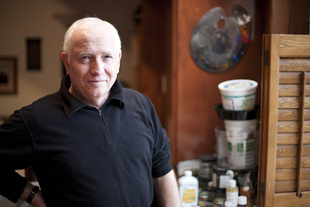
In interviews and captions you regularly refer to your wife as solid and sensible, the anchor to your flights of fancy. How has her influence affected your work?
Because of my nature—artist, head in the clouds, struggling to keep balanced, to keep grounded—I can get carried away. I don’t know, maybe we could call it the artistic spirit and maybe we could call it a little ADD affliction.
My wife is my partner. We actually work quite well together. She is the business end of the pair of us. I do think of it as a true partnership. If you were to film her, she would say, “I do everything else, so that James can paint.”’ She doesn’t always say that in the nicest way. But she does carry a lot of the day-to-day stuff on her shoulders because simply to get the work done you’ve got to have your head in the work. I really appreciate the relationship we have had.
In fact, I did a painting called “Poofy Guy on a Short Leash” which directly is about our relationship. I would just float up into the air and pop somewhere if I didn’t have her holding on to the other end.
Tell us how “whimsy is a serious subject” with you.
Well, with my family, we do crazy things, and people on the outside will go, “Oh my gosh, your family is so off the wall!” Some of it is just the way we are. But whimsy is important and imagination is important. I do a lot of work that isn’t gospel-oriented, scriptural, or even profound; it’s fun, whimsical, light. A person will come up to me and say, “Don’t get mad at me, but I hung this piece in a bathroom and every day your goofy piece of art makes me smile.” That is wonderful compliment for me, and its making someone smile every day justifies its existence.
I think we need to lighten ourselves up. And I believe that my imaginative art becomes a catalyst or a trigger so that when people see my work, they’ll think up stories about what it means or who the characters are. Then they’ve exercised their imagination and become a contributor to the work and to the process.
I sometimes get classes where the teacher puts up one of the fairy tale pieces or nursery rhyme pieces and the students pick a character and write about them. That gives me warm fuzzies all over and gets me into the next painting. Once in a while some energetic teacher will send a big FedEx box with twenty or thirty of these wacky little stories. They are pretty fun.

Tell us the meaning of your magic fish.
The fish symbol is a pretty ubiquitous theme in my work, though not in every painting. I’ve had people come up to me and say, “I’ve spent four hours staring at ‘Gethsemane’ and I can’t find the fish!” and I say, “It’s Gethsemane! There are no floating fish in Gethsemane!” “But you have a floating fish in all your work!” No, I don’t, actually. That’s another myth.
But they are in some. They float around and they aren’t affected by gravity, so you can put them in wherever you want on that picture plane, real or imagined. They came to me, to begin with, to mean “This painting isn’t here.” Fish don’t float around “here,” so you are immediately transported to somewhere else.
Then I started reading and doing research into symbols. The fish is a symbol of hidden knowledge and a symbol of a path to a higher plane. People who aren’t LDS think, “Oh, we know why you put a fish in your painting—it’s because you’re a Christian.” And there’s the symbol of the Greek letters that spell “Christ” in the Greek language, and yes, it was used very early on and all that. But that has never been a primary mover in why I’ve done it. I’ve done it because it seemed whimsical and magical and it transports us and reminds us that this is another place.
I don’t really have a problem separating the Spirit from magic. Once in a while I get in trouble in some kind of Church thing—“Magic, that’s druids and Satanic.” I even got in trouble because I was playing a kind of Dungeons & Dragons game with my kids and a couple of the neighbors weren’t allowed to come over because we had wizards and witches and that kind of “Satanic stuff” in it. We were always able to leave that kind of stuff in the realm that it’s in. I never struggled with Bambi because Bambi was allowed to talk—that was the world that was created for that character, and I do the same thing. I have very strong feelings about the Spirit and the way that it operates in my life and about the inspiration I receive when I’m doing what’s right, where I know I am being watched over constantly and protected and cared for—and nudged. I don’t really have any problem confusing that with the higher forces of the seventh level of necromancy.
Do you have fun being Mormon?
I am Jim Christensen and I’m a Mormon. [laughter] And I have fun.
Of course. I have joy, which is more important. I love the people I work with and associate with. I love the congeniality of like-minded people. And I love service. I mean, my work currently as a bishop in a student ward is very rewarding to me.
Are there tough moments? Yes. Are there things that I wish I didn’t have to deal with? Of course there are.
But at the same time, you see the lights go on and you see people regain their birthright, and it’s a wonderful, wonderful experience.
And we laugh a lot. I had my Relief Society president tell me a couple of weeks ago, “We are having expanded ward council, and I have to say, I can hardly wait. We laugh so hard in ward council. It’s fun.” And I think it should be fun. So, yes, I have a lot of fun being a Mormon.
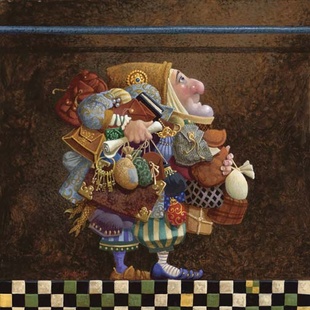
What’s next?
I don’t know how long I will be able to keep doing this. I don’t envision retirement in my life. My gut feeling is that they will pry the brush from my cold dead hands. My artist friends and I are all getting a little older, but we’re trying to stay in shape, because we all want to keep working.
I was afraid when I first quit my day job at BYU that I was going to run out of ideas. At the time the best comparison I could make was with a woman’s ovaries—you’re born with x number of ideas. You know, you’ve got eggs and they keep coming down the chute, but at some point in time, you are going to hit artistic menopause. The last idea has bumped its way down my artistic fallopian tubes. And that’s it. I’m through. I can never think of it again.
What I found when I quit my day job and I was working and using up ideas at a quicker rate was that I generated more ideas. That’s where I am now. I’ve gotten over that fear of menopause. I simply think that the more we think, the more we imagine, the more we read, the more we travel, the more we ponder, the more we mature and look at the same stories from a different point of view, the more ideas happen.
If there’s a negative idea about being a sixty-eight year old painter, it’s that a lot of the ideas have already been done and you’ve got to keep pushing yourself to get out on the edge of some new territory. But that’s the game and that’s the fascination of the whole process.
I don’t work as hard as I used to. I don’t paint as many hours as I used to in the studio because I just hurt in places. I’m just getting old. I spend more time with my grandkids and that kind of stuff.
But as far as I’m concerned, I am working on two big pieces now. I have a book planned for next spring that I am going to dive in and do fifteen or twenty illustrations for. Plus, I have a lot of paintings that I want to do. I see myself just going on with the work as long as I can. ❧
